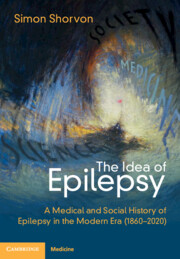Book contents
- The Idea of Epilepsy
- The Idea of Epilepsy
- Copyright page
- Dedication
- Contents
- Preface
- Section 1 The Voyage Of The Good Ship Epilepsy
- Section 2 ‘A Plague upon Your Epileptic Visage’
- One 1860–1914: The Birth of Modern Epilepsy
- Two 1914–1945: Epilepsy in the Age of Catastrophe
- Three 1945–1970: Epilepsy and the New World Order
- Four 1970–1995: Epilepsy in a Globalised World
- Five 1995–2020: The Epilepsy Floods are Too Recent
- Section 3 Epilepsy: The Paradigm of the Suffering of Both Body and Soul in Disease
- Book part
- Glossary
- Bibliography
- Index of Names
- Index
One - 1860–1914: The Birth of Modern Epilepsy
from Section 2 - ‘A Plague upon Your Epileptic Visage’
Published online by Cambridge University Press: 13 January 2023
- The Idea of Epilepsy
- The Idea of Epilepsy
- Copyright page
- Dedication
- Contents
- Preface
- Section 1 The Voyage Of The Good Ship Epilepsy
- Section 2 ‘A Plague upon Your Epileptic Visage’
- One 1860–1914: The Birth of Modern Epilepsy
- Two 1914–1945: Epilepsy in the Age of Catastrophe
- Three 1945–1970: Epilepsy and the New World Order
- Four 1970–1995: Epilepsy in a Globalised World
- Five 1995–2020: The Epilepsy Floods are Too Recent
- Section 3 Epilepsy: The Paradigm of the Suffering of Both Body and Soul in Disease
- Book part
- Glossary
- Bibliography
- Index of Names
- Index
Summary
The modern era of epilepsy can be said to date from around 1860. In the ensuing decades epilepsy was at the centre of an enormous range of endeavours which included Hughlings Jackson’s landmark works, the theory of cerebral localisation, the introduction of bromide and then phenobarbitone therapy and the first attempts at the surgical resection of the epileptic focus. It was the period when idiopathic epilepsy (‘genuine epilepsy’) was considered to be an inherited degenerative brain disorder, associated with mental symptoms and deficiency and a specific ‘epileptic personality’. It was the period when neurology first became a recognisable medical specialty, special hospitals for epilepsy opened and epilepsy colonies were formed all over the world. Lombroso considered epilepsy and criminality to have close connections. Inpatient treatment was conducted within the asylum system by psychiatrists. Epilepsy was associated with enormous stigma and was widely hidden or denied. In 1911, eugenics was proposed as a solution to the problems caused by epilepsy. Dostoyevsky, Zola, Dickens, Hardy and others included epilepsy in their books, and leading authors suffered from epilepsy but concealed their condition. International medical and psychiatric congresses were held, and during one of these, the International League Against Epilepsy was formed.
Keywords
- Type
- Chapter
- Information
- The Idea of EpilepsyA Medical and Social History of Epilepsy in the Modern Era (1860–2020), pp. 29 - 147Publisher: Cambridge University PressPrint publication year: 2023

